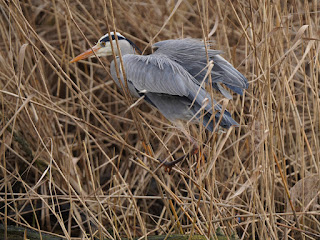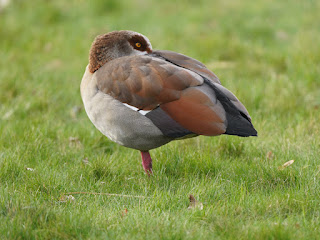The freezing weather is over for the time being and things are getting back to normal, but it will be a few days till all the ice is gone.
A Carrion Crow at Peter Pan picked up some food someone had thrown on the ice, maybe breadcrumbs or porridge oats. Probably in normal times they wouldn't bother with such small things, but the frozen ground has made it hard for them to get better food such as worms.
The pair of Magpies near the bridge were eager for peanuts, but then they always are.
The Robin by the Henry Moore sculpture was expecting prompt attention with a pine nut, and was annoyed by being photographed.
The ice has melted at the edge of the Lido restaurant terrace, and a Starling was having a bathe in the chilly water.
A Wood Pigeon browsed near the Dell. It was not eating the snowdrops. They are poisonous, and the bird knows that.
Tom got an excellent shot of a Treecreeper by the leaf yard yesterday.
Black-Headed Gulls took off from the melting ice on the Long Water.
A Grey Heron fished in the reed bed by the Italian Garden.
The pigeon-eating Lesser Black-Backed Gull was preening his immaculate plumage on the ice by the Dell restaurant. He is very fussy about his appearance and always washes the blood off his face after one of his grisly meals.
I think there are just two Common Gulls that compete for a place on the No Swimming sign here. This one is female judging by the rounded shape of its head, and has pale yellow legs. The other one, evidently male and with ivory legs, can be seen in my blog post for 15 January, about to be knocked off the sign by the female.
The Great Crested Grebes that nested in the willow by the bridge last year have shown up again, and were displaying next to their nest site. Let's hope they have the good sense to wait till later to start nesting.
The male Egyptian Goose of the pair by the Henry Moore sculpture has been alone for several days.
This probably means that his mate is nesting. I looked in the nearby dead tree where she has nested in previous years and could see no sign of her. However, the tree is decaying and she may have abandoned it for a more secure hole.
Virginia reports that a pair have also started breeding by the Round Pond. Most of the Egyptians have adjusted to the northern seasons but there are still some that are absolutely clueless about a good starting time.
You can see in the picture above that the male Egyptian has a slight mane on the back of his neck, similar to that of a male Maned Goose -- see my picture of one of these on the Round Pond in 2015. I was wondering whether only male Egyptians have these manes. However, Maned Geese are a bit closer to ducks than Egyptians are in the uncertain zone between geese and ducks, and the males have different plumage from the females, while in Egyptians the sexes are the same colour, as with larger geese.
Barry Jones sent me an interesting picture taken yesterday of an Egyptian with quite a long mane blown about by the wind.
Virginia took these two fine pictures today. A Mute Swan was trying to take off from the ice on the Long Water. Swans can take off from dry land with a desperate flat-out run, but this one couldn't get up to speed on the slippery ice. After several failed attempts it had to waddle awkwardly to the open water by the bridge.
A pair were courting in a melted pool on the Serpentine.
An unusual picture taken last night by Jenna on her phone in pitch darkness. A fox was waiting on the edge of the Serpentine to see if any birds were incautiously sleeping on the ice so it could run out and grab them.
The remains of the Winter Wasteland have been almost completely removed, leaving a huge area of devastation, and the wooden hoarding is being taken down and replaced with a fence. Soon the massive returfing operation will begin -- and soon we shall see the big January flocks of Redwings descend to haul worms out of the ruined ground.
One curious leftover from the Wasteland: the daffodils along the edge of the horse track have already begun to emerge. These ones were covered with a ramp to allow ambulances to drive into the enclosure, and have come up yellow and twisted. It will be interesting to see if the manage to recover and flower.




%202024%201a.jpg)





%202024%201a.jpg)
%202024%201a.jpg)
%202024%201a.jpg)
%202024%201a.jpg)


I remember the Maned Goose’s visit, and also the Scaup that you mention in your 2015 blog. I used to spend a long time in the cold winds at the Round Pond watching the Scaup
ReplyDeleteIf I remember rightly, it arrived in juvenile plumage and grew up before our eyes.
DeleteBill deformity on the Carrion Crow, though nowhere near as extreme as on Friday's Great Tit. Re Egyptian Geese, there are similar indications that the most recent resident pair in Golders Hill Park have just started nesting. Jim
ReplyDeleteThese slightly hooked bills seem to be quite common in crows.
DeletePoor silly Egyptians, will they ever grow out of their tropical delusions?
I do hope the daffodils manage to recover. That's an interesting picture of the fox and treecreepers are always wonderful
ReplyDeleteTreecreepers can crop up anywhere. You can't go to places where you expect to see one, they just have to happen. I have just twice found a Treecreeper's nest under a flake of bark, which gave a chance of getting pictures of them coming and going. But that's a rare sight.
ReplyDeleteWow, that's impressive. Real Springwatch stuff
DeletePure luck.
DeleteEgyptians are getting the run of the place here. They first appeared in our birding patch two years ago. By now they are lords and masters of all they survey. They breed and breed and breed.
ReplyDeleteWorth noting that the Egyptian hieroglyph for 'son of', seen in the names in royal cartouches under a sun disc for 'son of the Sun', is an Egyptian Goose -- no doubt because they are so recklessly prolific.
Delete